Food Games for Kids: Tasty, Fun, and Educational
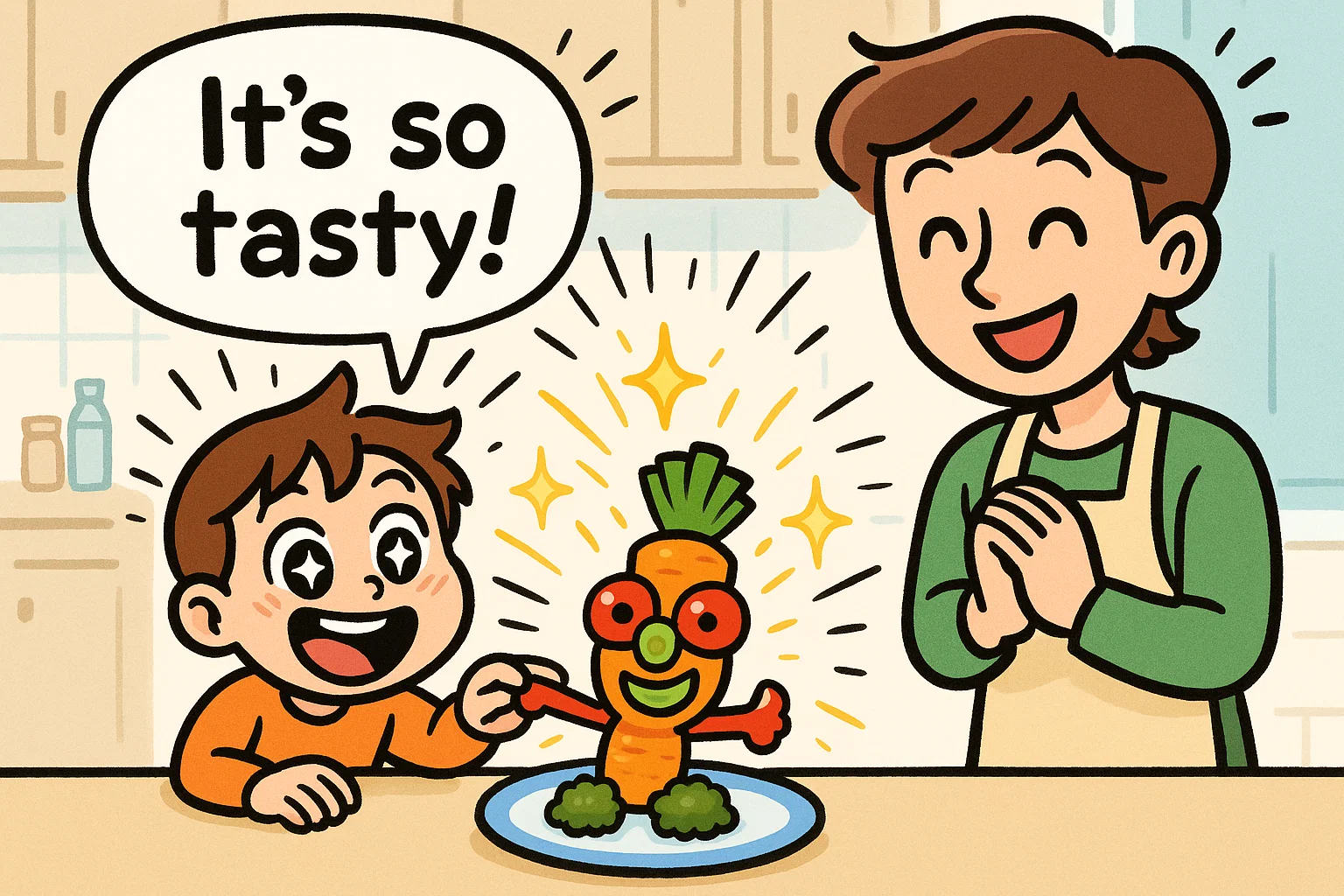
Mealtime struggles and kitchen chaos—sound familiar? Transform these daily challenges into opportunities for learning and bonding through play. When children interact with what they eat in creative ways, something remarkable happens: they become more adventurous eaters, develop essential skills, and build lasting positive associations with nutrition.
Benefits Activities: Why Play Food?
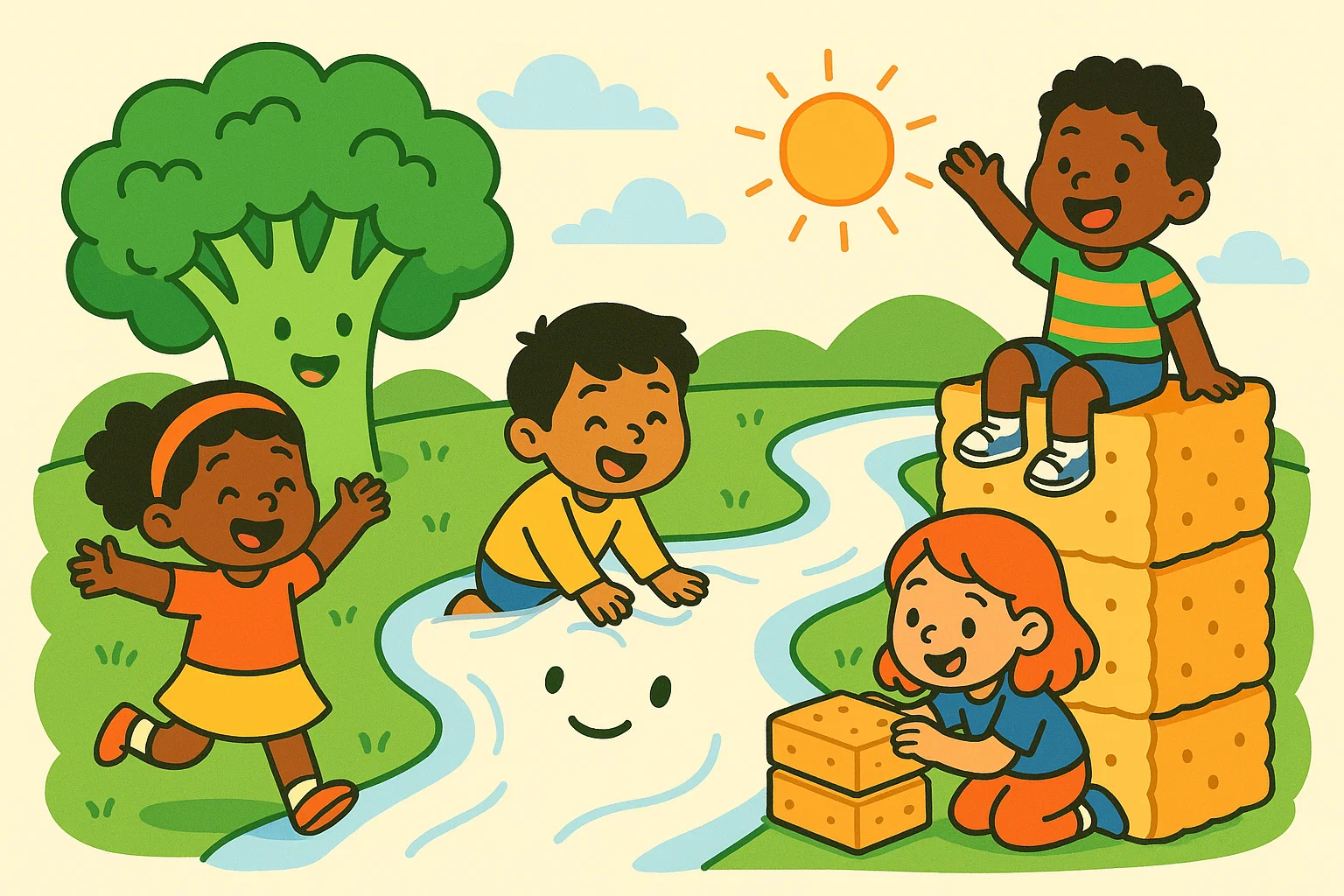
Turning the kitchen into a playground does more than just entertain. Let’s look at the specific and measurable reasons why experts recommend this approach.
Motor Skill Development Food Manipulation
Simple actions that build the foundation for essential tasks:
- Picking up slippery fruit pieces
- Arranging crackers into patterns
- Threading cereal onto string
These seemingly simple actions build the foundation for writing, buttoning shirts, and countless daily tasks. Fine motor control develops when little fingers pinch, grasp, and manipulate different textures.
Sensory Exploration Taste, Texture, Smell
Every ingredient tells a story through your senses. Explore the story of food through these sensory cues:
- Rough strawberry seeds
- Smooth yogurt
- Crunchy carrots
Each texture teaches the brain to process information. When kids touch raw pasta before cooking and then compare it afterward, they’re conducting scientific experiments. Sensory play with edibles helps reduce picky eating by familiarizing children with variety in a low-pressure environment. Unlike forced tasting at the dinner table, exploratory play lets them investigate at their own pace. Some may start by just looking, then touching, eventually working up to taste.
Emotional Connection Food Positive Experiences
Happy memories formed in the kitchen last a lifetime. When a child associates cooking with laughter, creativity, and praise rather than pressure or stress, they develop a healthier relationship with eating. This emotional groundwork can prevent disordered eating patterns later.
Consider this: a kid who helps assemble their own snack feels ownership and pride. That cucumber they cut (with supervision) suddenly becomes more appealing than one simply placed on their plate. Autonomy matters, even in small doses.
Boost Creativity Imaginary Kitchen Roles 🎨
Pretend play reaches new dimensions when ingredients become props. That broccoli transforms into a tree, mashed potatoes into snow-covered mountains. Role-playing as a chef, restaurant owner, or food critic allows children to explore social dynamics and practice communication.
The beauty lies in open-ended possibilities. There’s no wrong way to arrange fruit on a plate or build with vegetables. This freedom from rigid rules encourages experimentation and builds confidence in decision-making.
Play Food Safety Hygiene
Teaching proper handling early establishes habits that last. These hygiene lessons stick better through practice than lectures:
- Washing hands
- Understanding cross-contamination
- Recognizing spoiled items
Making hygiene part of the game rather than a chore changes the entire dynamic. Set up a “safety checkpoint” where everyone must complete a handwashing ritual before playing. Use songs or timers to make it engaging rather than tedious. When children understand why these rules exist, compliance comes naturally.
Types Food Games: Kitchen Play Developmental Activities
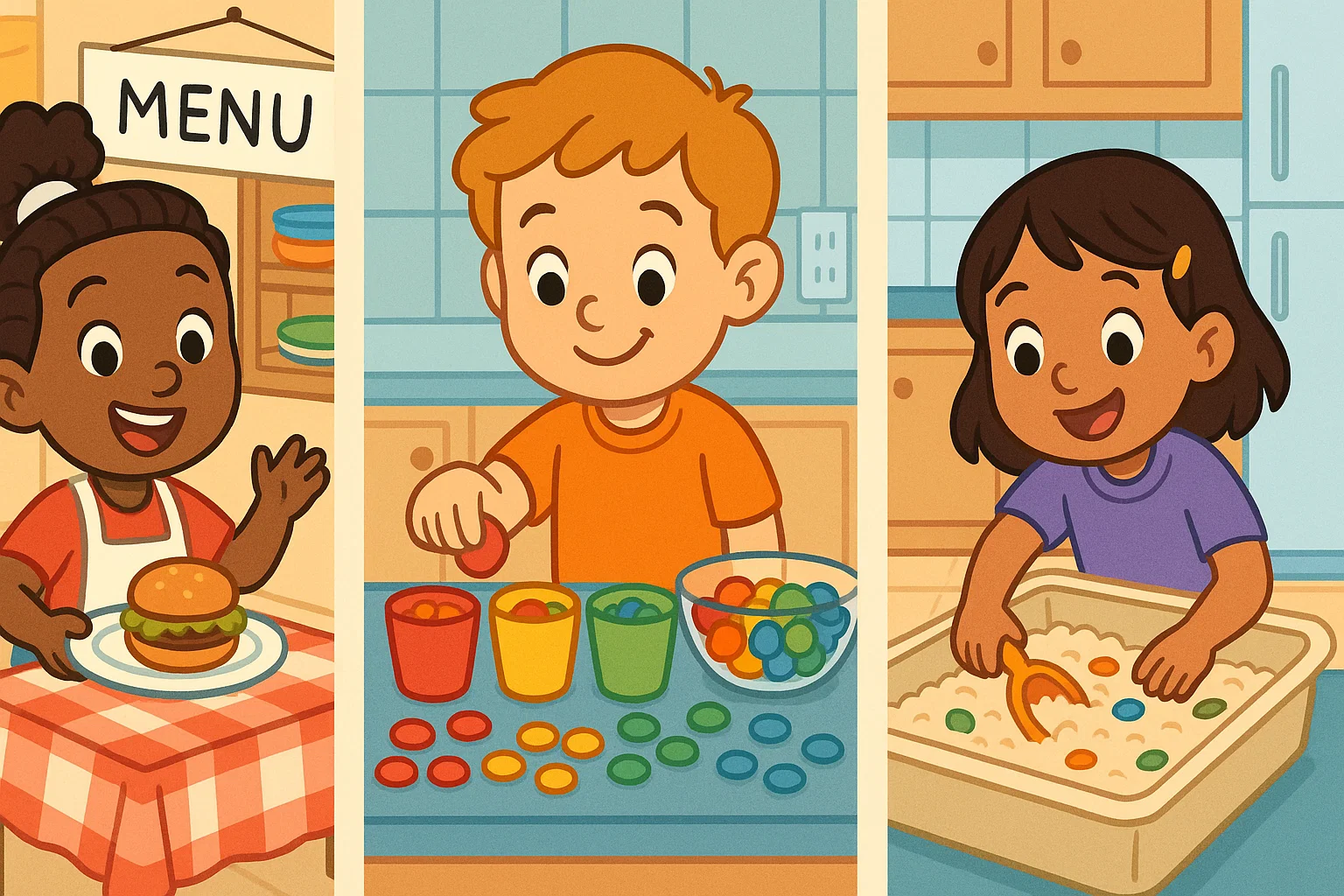
Ready to jump in? From sensory bins to role-play scenarios, here is a list of creative ways to put this philosophy into action and target key developmental areas.
Sensory Games Touch Texture
Fill containers with rice, dried beans, or oats and hide small toys inside for a treasure hunt. Provide scoops, funnels, and cups for pouring practice. The varied textures stimulate nerve endings while teaching concepts like volume and measurement.
Create a “mystery box” with different ingredients inside. Blindfolded participants guess what they’re touching—is it squishy gelatin or firm cheese? This builds descriptive vocabulary and deductive reasoning skills.
Role-Play Games Miniature Kitchen Setup
A designated play kitchen area, even a simple one made from cardboard boxes, becomes a stage for elaborate scenarios. Stock it with safe utensils, empty food containers, and play dishes. Children might run a restaurant, prepare meals for stuffed animals, or host tea parties.
The social learning here is profound. Taking orders, serving others, cleaning up afterward—these mirror real-world responsibilities. Siblings learn negotiation skills when deciding menu items or dividing tasks.
Educational Games Counting, Colors, Letters 📚
Sort snacks by color into muffin tins: red strawberries here, green grapes there. Count out specific numbers of crackers for each family member. Spell names using alphabet pasta or letter-shaped cookies.
These activities make abstract concepts concrete. A child struggling with number recognition may grasp it instantly when counting actual objects they can eat. The motivation factor changes everything.
| Skill | Game Example | Age Range |
| Counting | Counting berries into bowls | 2-4 years |
| Colors | Sorting fruit by rainbow order | 3-5 years |
| Letters | Finding alphabet in cereal | 4-6 years |
| Patterns | Creating AB patterns with crackers | 4-7 years |
Group Challenge Games Team Cooperation
Divide kids into teams for relay races carrying spoons with ping-pong balls (or small fruits for older children). Set up obstacle courses where they must balance a cookie on their forehead while walking. These silly challenges teach persistence and good sportsmanship.
Competition can be healthy when the focus stays on fun rather than winning. Celebrate creative strategies and mutual encouragement alongside successful completions.
Creative Games Food Art Sculptures
Provide toothpicks, fruits, vegetables, cheese cubes, and let imaginations run wild. Children might construct animals, buildings, or abstract sculptures. The three-dimensional aspect adds spatial reasoning practice.
Document creations with photos before eating them. This preserves the artwork digitally while still allowing consumption—a practical solution that honors their effort.
Easy Food Games Toddlers: First Steps Tasty Play
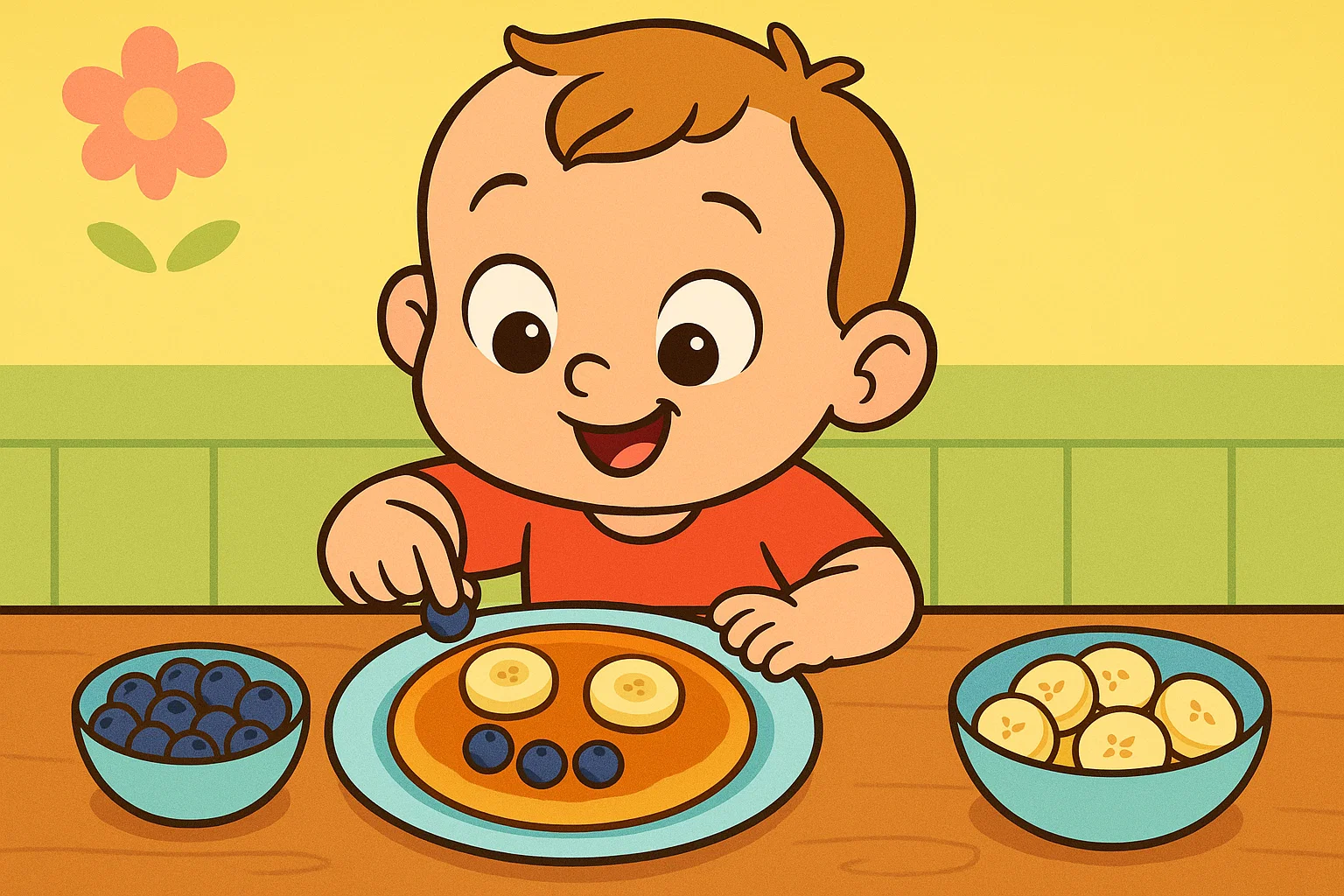
For the youngest explorers who are just getting to know the world, we need the simplest and safest activities. These starter ideas are perfect for tiny hands and building early confidence.
Pancake Faces Simple Decoration
Materials to spark imagination and construction:
- Toothpicks
- Fruits
- Vegetables
- Cheese cubes
Provide these materials, and let imaginations run wild. Children might construct animals, buildings, or abstract sculptures. The three-dimensional aspect adds spatial reasoning practice. Document creations with photos before eating them. This preserves the artwork digitally while still allowing consumption—a practical solution that honors their effort.
Cereal Necklaces Fine Motor Skills
Threading cereal pieces with holes (like O-shaped varieties) onto string or yarn builds hand-eye coordination essential for future writing. The edible end product serves as both reward and snack.
Tape one end of the string to make it rigid like a needle—this helps little fingers guide it through holes. Keep strings short initially; four or five pieces may be plenty for a first attempt.
Letter Week Food Shapes
Choose a letter to focus on each week. Prepare snacks starting with that letter: apples, avocado, apricots for “A” week. Or shape bread, cheese, or deli meat into the letter itself using cookie cutters.
This multisensory approach reinforces letter recognition more effectively than flashcards alone. The child sees, touches, and tastes the letter, creating stronger neural connections.
Food on DIY Spinning Plate
Turn a lazy Susan or create a simple spinning platform using a paper plate on a plastic cup. Place various bite-sized foods around the edge. Spin it and whatever stops in front of the child becomes their next taste.
The element of chance removes pressure. “The plate decided” takes away the decision-making burden that sometimes triggers refusal in young kids.
Marshmallow Spaghetti Towers Building Challenge 🏗️
Raw spaghetti noodles and mini marshmallows create an engineering playground. Pierce marshmallows onto noodle ends to build structures. This teaches balance, geometry, and the trial-and-error process.
Don’t worry about the mess—breakage is part of learning. Have plenty of materials available so construction can continue despite failures. The tallest tower might not be the goal; sometimes the most creative design wins.
Practical Games Kids Kitchen: Cooking Learning
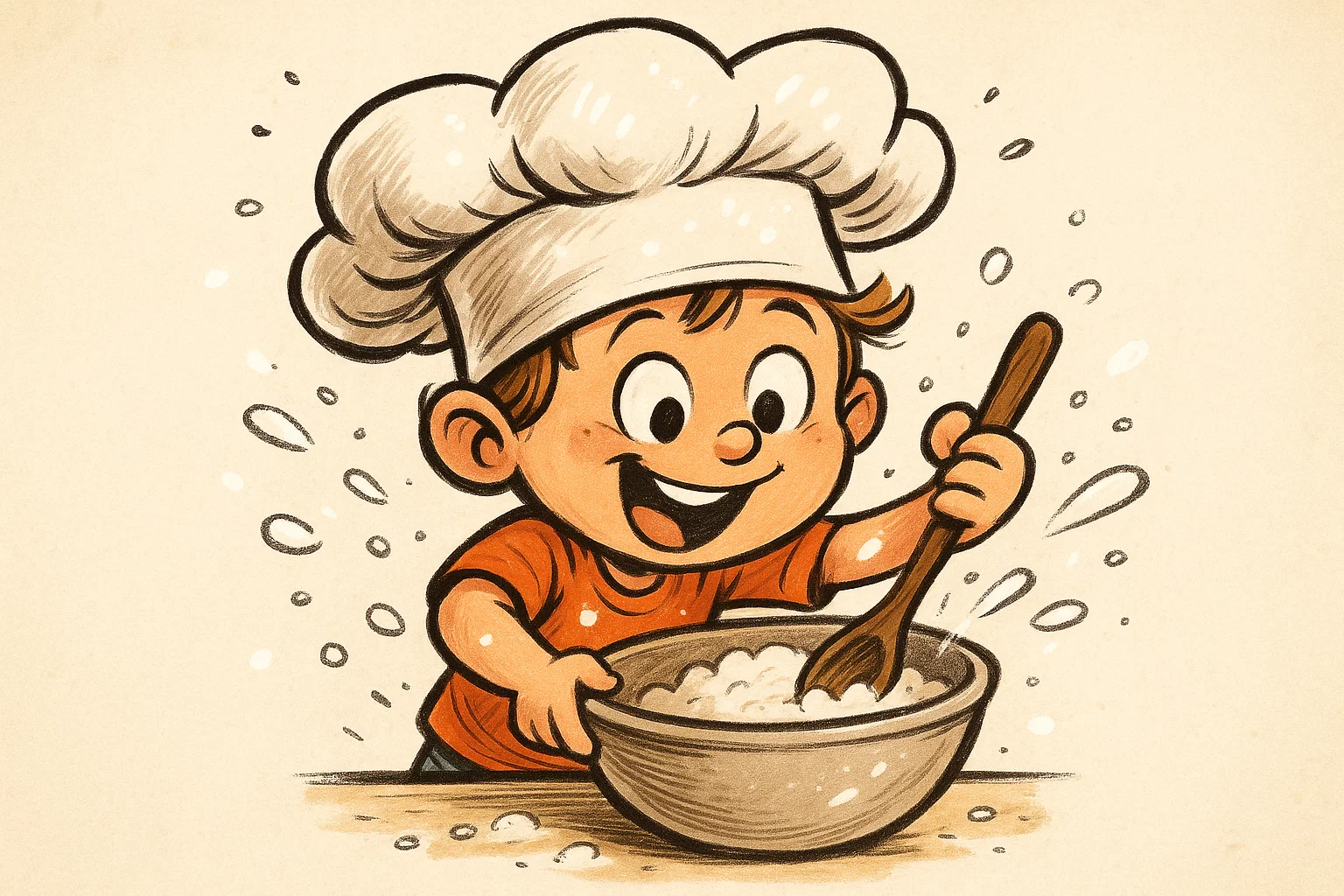
When your child is ready to move beyond simple manipulation, these activities turn basic meal prep into a valuable life lesson and boost their independence.
Young Baker Simple Recipes
Start with no-bake recipes requiring basic steps. Start with these basic steps in simple recipes:
- Stirring
- Pouring
- Measuring
Energy balls made from oats, nut butter, and honey let children combine ingredients and roll mixtures into spheres. Success feels achievable even for beginners. Provide picture-based recipe cards showing each step visually. This allows pre-readers to follow along independently, building confidence and literacy skills simultaneously.
Culinary Detective Ingredient Identification
Prepare a simple dish, then challenge children to identify what went into it by taste and smell. Was there cinnamon in those muffins? Did the sauce contain garlic? This sharpens sensory awareness and introduces cooking concepts.
Vary difficulty based on age: obvious ingredients for younger kids, subtle seasonings for older ones. Discuss how combining items creates new flavors—the foundation of understanding recipes.
Edible Pictures Plate Art
Provide a variety of colorful ingredients and let children create scenes on their plates: a garden made from broccoli trees and carrot flowers, an underwater scene with blue yogurt water and fish-shaped crackers.
This transforms the plate from a battleground into a canvas. Eating the artwork feels like a natural conclusion rather than a forced task. Some children who resist “eating dinner” will happily consume their creation.
Fun Sorting Shapes Colors
Give kids different shaped pasta (bowties, spirals, shells) mixed together. Provide containers labeled by shape or color. Sorting activities develop categorization skills while keeping hands busy.
Extend the activity by discussing which shapes might work best in different dishes. This introduces practical knowledge about cooking while maintaining the playful approach.
Fruit Skewers Simple Preparation
Child-safe skewers or straws allow kids to create their own fruit kabobs. Choosing which pieces go where, deciding on patterns, and managing the assembly process all contribute to executive function development.
Offer dipping options like yogurt or a small amount of chocolate sauce. The interactive element of dipping adds another layer of engagement and sensory experience.
Learning Food Games Kids: Taste Health Education
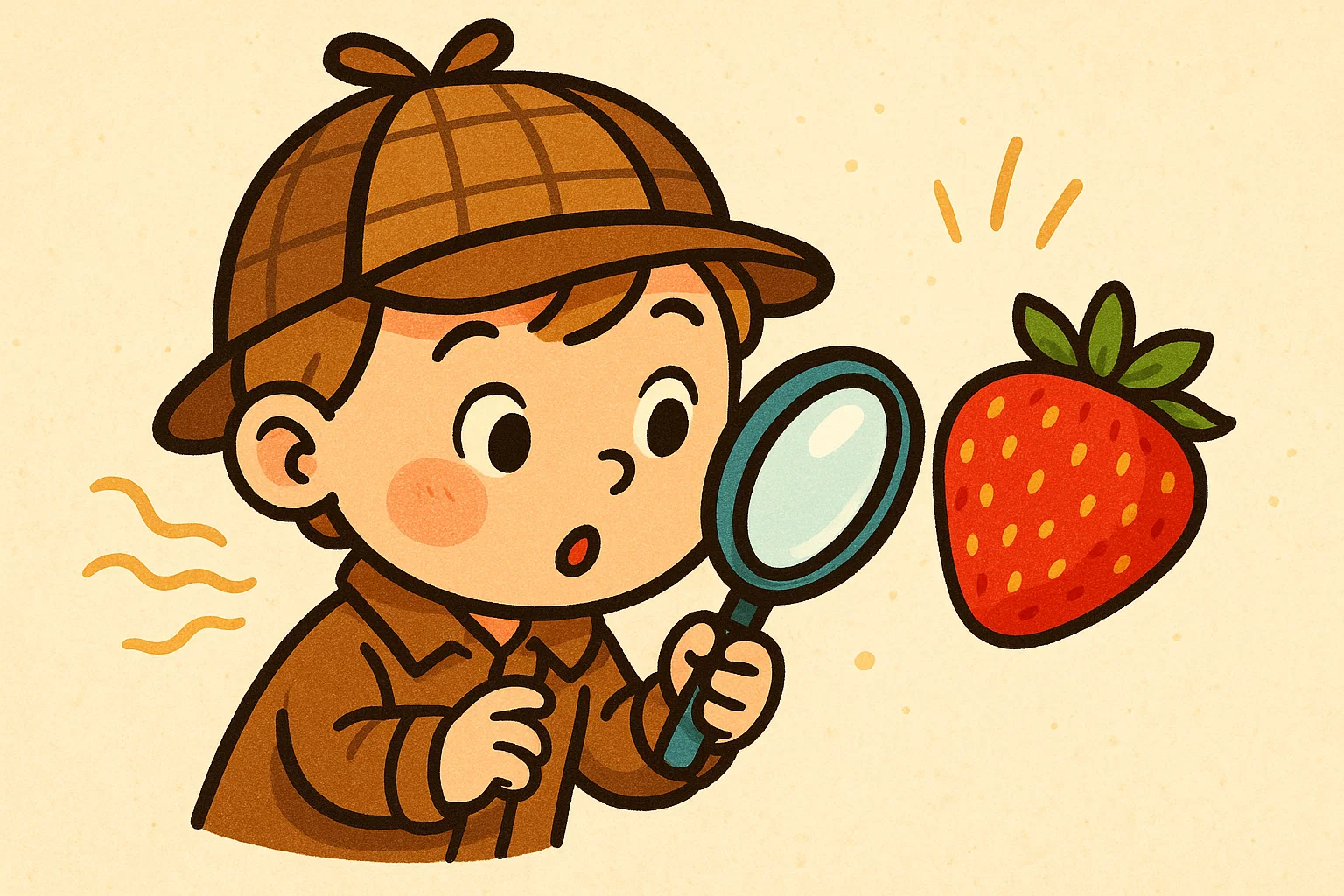
The best way to teach a child is to turn a lesson into a game. It’s time to explore how exactly you can cultivate a love for healthy eating and expand their knowledge of ingredients.
Blind Taste Test Sensory Development
Blindfold participants or have them close their eyes, then offer small samples of various items. Can they identify the food? Describe its qualities? Guess if it’s sweet, salty, sour, or bitter?
This game heightens awareness of taste independent from visual cues. Many kids realize they enjoy foods they thought they disliked—they just needed to experience them differently. Start with familiar favorites before introducing new items.
Veggie Guessing Game Identify Vegetables
Place cut vegetables in a bag or under a towel. Children feel the shapes and textures to guess what each one is. This removes visual bias and focuses on tactile properties.
Discuss the findings: carrots feel harder than cucumbers, peppers have distinct ridges, celery has strings. Vocabulary expands naturally through description and comparison.
Grocery Store Bingo Food Groups 🛒
Create bingo cards featuring different food categories: proteins, fruits, vegetables, grains, dairy. During shopping trips or while unpacking groceries, kids mark off items they spot. First to complete a row wins.
This teaches food group classification in a practical context. Children begin understanding nutrition basics without formal lessons, simply through repeated exposure and categorization.
Measure Guess Kitchen Math
Before measuring ingredients, have kids estimate amounts. Will this bowl hold more rice or less than they think? How many tablespoons equal one cup? These predictions engage mathematical thinking.
Reveal the actual measurements and discuss why predictions were close or far off. This process teaches estimation skills valuable in countless life situations beyond the kitchen.
Journey Food Origins Nutrition
Explore where different foods come from: apples grow on trees, milk comes from cows, flour is ground from wheat. Show pictures or videos of farms, orcheries, and food production.
Understanding origins creates respect for ingredients and the work involved in bringing them to the table. Some children become more willing to try items after learning their stories.
Name Food Recognition Game
Flash cards showing various ingredients challenge kids to name them quickly. Include common items plus a few unusual ones to expand their culinary vocabulary. Time the responses to add excitement.
Repeat regularly with increasing difficulty. What started as recognizing an apple progresses to distinguishing between apple varieties—Granny Smith versus Fuji, for instance.
Eating Games Picky Eaters: Changing Food Relationship
The struggle over every bite can be exhausting. These games help lower the pressure and turn the plate into a creative canvas, fundamentally changing their relationship with food.
Create Little People Fun Food Presentation
Use vegetables, fruits, and other ingredients to build characters on the plate. A cucumber body, tomato head, carrot stick arms—suddenly these ingredients become part of a story rather than foods to resist.
Engage children in naming their creations. “Mr. Broccoli Head” feels like a friend rather than a dreaded vegetable. The emotional connection shifts from negative to positive through play and personification.
Take Bite Game Small Portions
The pressure to finish everything can overwhelm picky eaters. Instead, make the goal just one bite—called a “discovery bite” or “adventure taste.” No requirement to like it, just to try.
Offer a “yuck bowl” where rejected foods go without judgment. Simply trying deserves celebration. Over time, some items migrate from the yuck bowl to the accepted list, but patience matters more than immediate success.
Cookie Cutters Themed Lunches
Transform sandwiches, cheese slices, and watermelon into stars, hearts, or dinosaurs using shaped cutters. The familiar ingredient appears novel and exciting when presented differently.
Theme entire meals: space lunch with star sandwiches and moon cheese, ocean theme with fish-shaped items and “seaweed” (cucumber strips). The narrative element captures attention and imagination.
Using Unusual Fun Plates Presentation Tricks
Serve meals on unexpected surfaces: a cutting board turned into a platter, a muffin tin with different foods in each cup, a bento-style container with compartments. The novelty factor increases interest.
Let children occasionally choose their plate from options. This small choice grants control, reducing resistance. Empowerment through minor decisions can prevent power struggles over major ones.
Animal Faces Food Art 🦁
Extend the face-making concept to animals. Pancakes become bear faces with berry eyes and banana slice ears. Sandwiches transform into cats with cheese whiskers.
Provide reference pictures of animals for inspiration. Older kids might challenge themselves to create increasingly realistic representations, while younger ones enjoy abstract interpretations.
Potion Station Mixing Ingredients
Set up a “laboratory” with clear cups, safe liquids (juices, milk, water), and mix-ins (fruits, yogurt, honey). Children create “potions” by combining ingredients in their chosen proportions.
The experimental aspect appeals to scientific curiosity. Some combinations will taste terrible—that’s valuable learning. Others might discover favorite smoothie recipes through trial and error.
Food Games Parties: Group Fun Celebration
Food games aren’t just for quiet evenings at home. They can be the perfect, memorable element for any children’s party and guarantee group fun!
Ice Cream Sundae Relay
Teams race to build ice cream sundaes, with each member adding one topping before tagging the next person. The messy, chaotic fun creates lasting memories while teaching cooperation and sequencing.
Provide identical topping selections for each team to ensure fairness. The focus should be on speed and teamwork rather than sundae aesthetics, though you might award creativity prizes too.
Whipped Cream Hide-and-Seek
Hide small candies or fruits in bowls of whipped cream. Participants search with only their mouths—no hands allowed. This silly challenge guarantees laughter and sticky faces.
Have towels ready and establish cleanup protocols beforehand. The mess is part of the appeal, but preparation prevents stress. Consider playing outdoors if possible.
Donuts String Race
Hang donuts from strings at child height. Contestants must eat their donut without using hands. First to finish wins, but watching the attempts provides as much entertainment as the victory.
Adjust donut types based on age: cake donuts for younger kids (easier to bite), glazed for older children (more challenging). Ensure strings are secure to prevent accidents.
Spaghetti Eating Contest Silly Challenge 🍝
Less about speed, more about technique—who can eat one long noodle most elegantly? Or try the opposite: silliest eating method wins. This flips competitive eating into comedy.
Emphasize that this type of game is special party behavior, not everyday table manners. The distinction helps kids understand context-appropriate actions.
Smoothie Competition Friendly Challenge
Teams receive identical ingredient selections and must create the best smoothie within a time limit. Judges (adults) taste and rate them on flavor, color, and creativity.
Even “losing” teams get to drink their creations, so everyone wins. This teaches recipe development, measurement, and accepting feedback graciously.
Chopstick Challenge Dexterity Test
How many small items (grapes, marshmallows, cereal pieces) can someone transfer from one bowl to another using chopsticks in 60 seconds? This tests fine motor control and hand-eye coordination.
Offer child-friendly chopsticks with connected tops or practice chopsticks for beginners. The struggle is part of the fun, but tools should allow some success at every skill level.
Specialized Food Games: ESL, Special Needs Sustainability
Food play is highly adaptable and inclusive. Discover how to use these activities to build language skills, ensure accessibility, and foster ecological responsibility.
Food Games Kids Special Needs Inclusive Accessible Play
Adapt activities for diverse abilities by modifying rules, tools, and expectations. Children with sensory sensitivities might prefer foods separated rather than mixed, or need softer textures exclusively.
Visual supports like picture schedules help children with autism understand the activity sequence. Offering choices reduces anxiety: “Would you like to sort by color or size?” Simple modifications ensure everyone can participate meaningfully.
For children with motor challenges, larger pieces and adapted utensils make manipulation easier. Focus on what they can do rather than limitations. Success builds confidence regardless of the specific task completed.
Green Bites Food Games Recycling Sustainability ♻️
Teach environmental responsibility through kitchen play. Topics covered in sustainability food games:
- Sorting packaging by recyclable materials.
- Creating art from food scraps before composting.
- Discussing why wasting food matters.
- Learning how to store items properly.
Plan a “zero waste” snack challenge where children prepare something using every part of the ingredient. Apple cores become seeds for planting, peels become chips when baked. This circular thinking develops ecological awareness.
ESL Games Activities Language Teaching
Food provides concrete vocabulary practice for language learners. “Pass the apple” teaches nouns and verbs simultaneously through action. Memory games matching food words to pictures reinforce recognition.
Cooking together naturally incorporates “command” language: “Pour the milk,” “Stir slowly,” “Taste this.” The physical actions cement meaning better than textbook exercises. Pronunciation improves through repeated exposure in meaningful contexts.
Create bilingual labels for kitchen items and ingredients. Seeing both languages simultaneously builds connections. Storytelling using food as props engages multiple learning styles—visual, kinesthetic, and auditory.
Apple Pass Meal Routines Throw
Sit in a circle and pass an apple (or other food item) around while music plays. When the music stops, whoever holds the apple shares something: a favorite meal, food they tried recently, or what they ate today.
This combines physical coordination, listening skills, and verbal expression. The unpredictability keeps everyone engaged. For younger children, simplify to just passing practice without the sharing component.
Blindfold Guess What’s Bag Game
Place a food item in an opaque bag. A blindfolded participant reaches in to feel and guess what it is. This purely tactile experience removes visual identification, forcing focus on shape, texture, and size.
Include both raw and prepared versions of items: a whole potato versus mashed potatoes, for example. Discussing differences enhances observational skills and introduces food transformation concepts.
Organization Logistics: Planning Play Session
To ensure the fun runs smoothly and cleanup doesn’t become a nightmare, proper preparation is essential. Here are practical tips for safety, organization, and time management.
Interactive Support Apps Gadgets Help Food Games
Technology can enhance traditional activities. Apps like kitchen timers with fun sounds, recipe apps with step-by-step pictures, or food identification games on tablets complement hands-on play.
Balance screen time with physical activity. Use devices as tools within the larger experience rather than replacing it. A tablet showing how bread is made leads to actual dough-kneading practice.
Setting Simple Rules Boundaries Food Waste
Establish clear expectations before starting: “We taste everything we touch,” “Dropped food goes in the compost bin,” “Clean hands required.” Simple, consistent rules prevent chaos without being restrictive.
Discuss the importance of respecting ingredients. Explain that playing with food is different from wasting it—the goal is exploration and learning, eventually leading to consumption when appropriate. This nuance helps children understand context matters.
Choosing Right Materials Safe Setup
Safety comes first. Age-appropriate tools, supervision levels matching the activity, and awareness of allergies are non-negotiable. Keep sharp objects, hot surfaces, and choking hazards away from small children.
Create a designated play space that’s easy to clean. Lay down washable mats, use unbreakable dishes, and keep cleaning supplies nearby. Preparation reduces stress and allows focus on the experience rather than damage control.
| Age Group | Appropriate Tools | Supervision Level |
| 2-3 years | Plastic utensils, soft foods | Constant, hands-on |
| 4-5 years | Child-safe knives, varied textures | Close proximity |
| 6-8 years | Basic kitchen tools, some independence | Periodic check-ins |
| 9+ years | Standard equipment with training | Available as needed |
Time Management Play Cleanup Schedule
Plan activities when children are neither tired nor overly hungry—mid-morning or mid-afternoon often work best. Allow sufficient time for both the activity and cleanup without rushing.
Build cleanup into the game itself: “Who can put the most items away in 30 seconds?” This prevents the end from feeling like punishment. Make tidying a natural conclusion rather than a separate chore.
Get Everything Need Play Fun Food Games
Gather supplies beforehand to maintain momentum. Nothing derails an activity faster than stopping midway to locate missing items. Create a checklist for frequently played games to streamline preparation.
Stock a designated container with basics: food-safe coloring, toothpicks, safe skewers, cookie cutters, small bowls, and plastic utensils. Having a “games kit” ready reduces setup time significantly.
